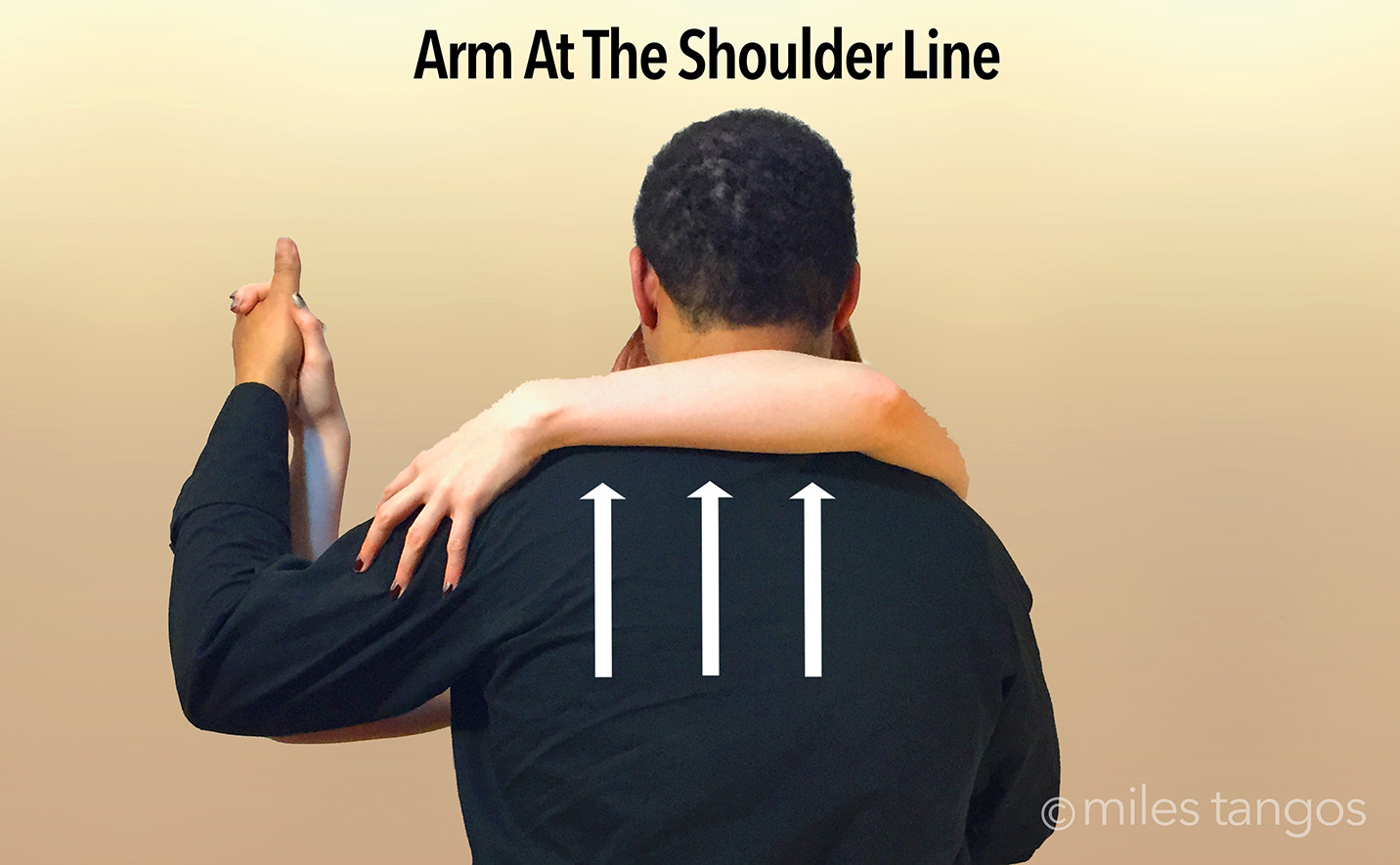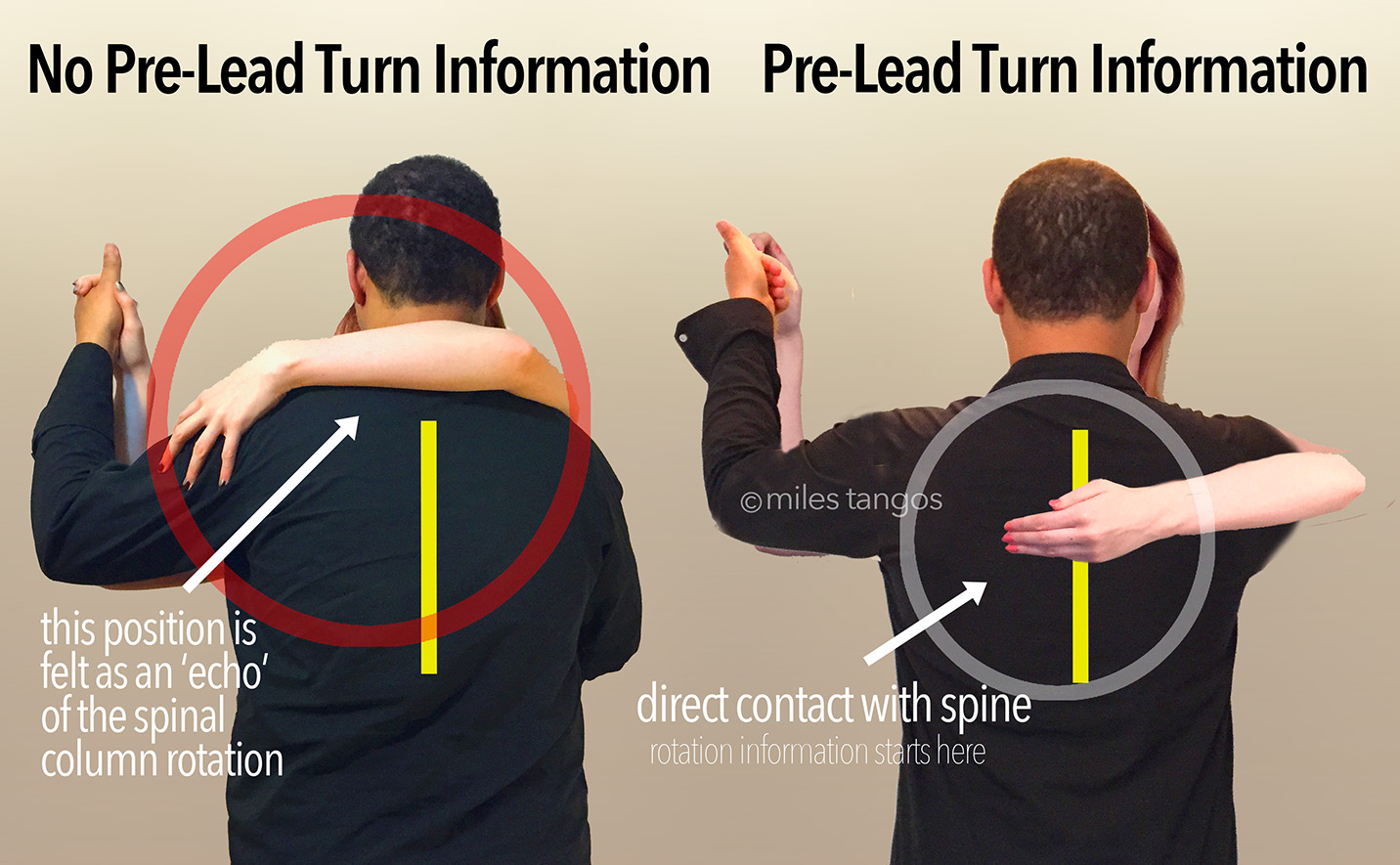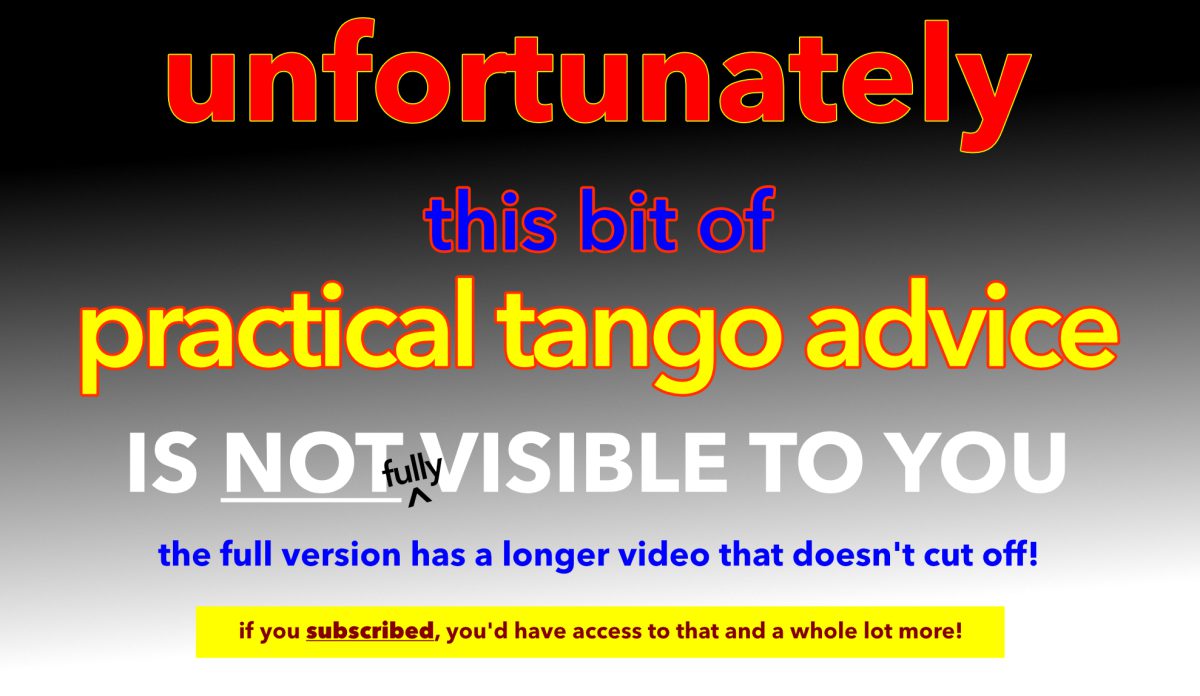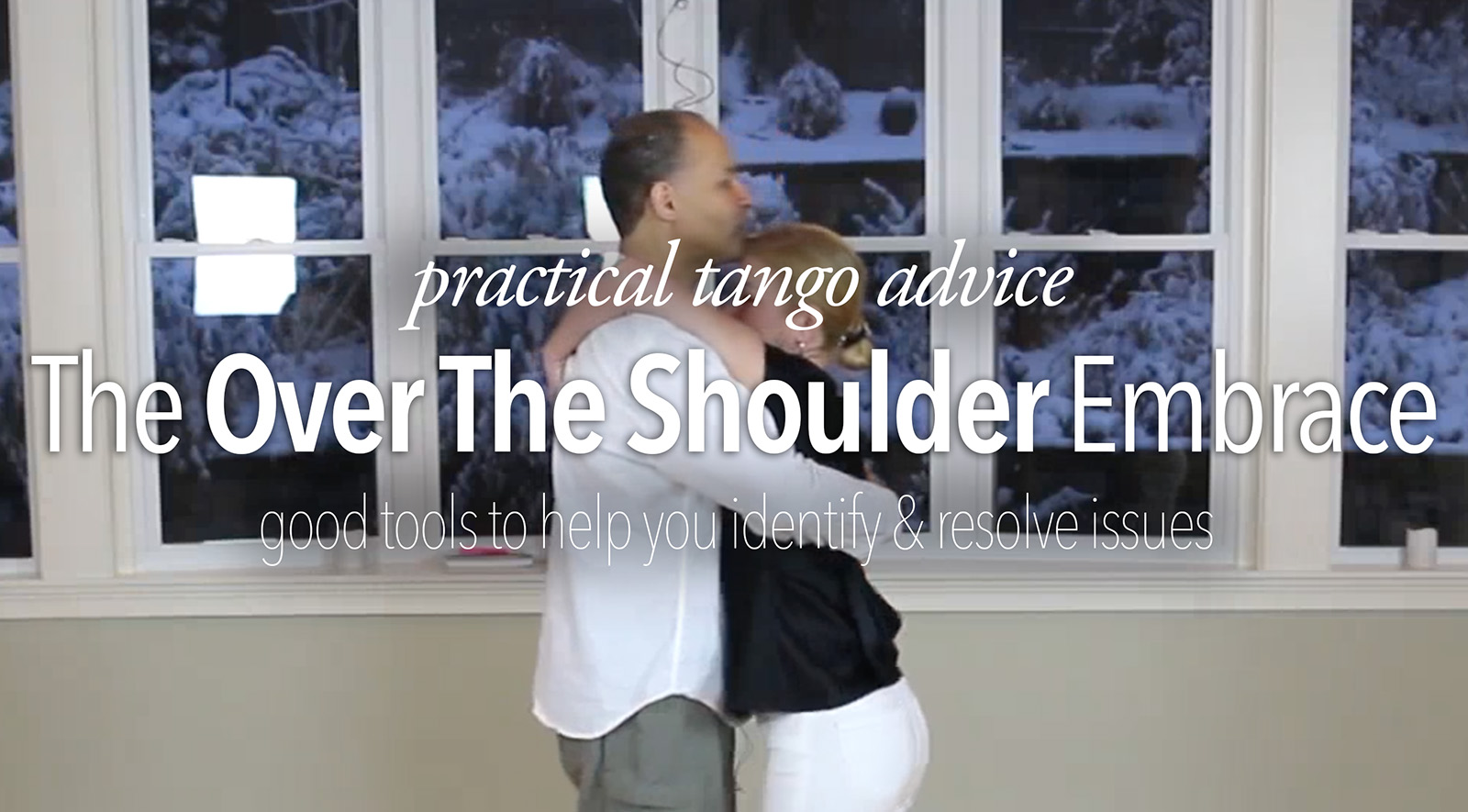Today’s Practical Tango Advice deals with an issue that you see all the time, and rather than tell you the million things that are less than desirable about this idea of the embrace. We’re going to show you 4 points that you absolutely must do in order to make this a desirable experience for the partnership. This post will in no way, shape, or form disparage the usage of this form of the embrace. Nor will it advocate or support it. It’s going to happen, we know that. And virtually nothing that this website has stated repeatedly, reminding you otherwise, with the Follower’s side of the embrace is going to change that, sadly. 🙁 The reality is that there are several traveling/performing Tango Teachers (not naming names, as you know who they are) that employ this practice in their embrace format. You, as the Tango going public, are going to see this stuff and think to yourself that this format is what you’re supposed to do (you’re not, but that’s what you’re going to think). “Well, if X Famous Follower Teacher does it, I should too”, and “They’re a teacher and they know best so….”, and/or “I studied with X and they said…” and from that moment forward it becomes codified in your Tango behavior and structures without any logical, or rational reason why you’re doing it. Regardless of what Tango Topics says is desirable or less than desirable about the form and just how many ways it doesn’t work for you or your vocabulary (the Follower’s Molinete, the Milonguero Turn, The Argentine Cross…just to name a few), it’s what you’re going to do. So if you’re going to do it, you may as well learn how to do it well so that it doesn’t kill you metaphorically speaking, or your partners!
A Bit of Embrace Confusion (in Terms): The Follower’s Arm Across The Shoulder (see image below) not Over The Shoulder. The term that we’re using to define and/or describe this state of the Follower’s Embrace and the effect that it has on the L/lead should not be confused with another item, and that’s the Follower’s Arm Across the Lead’s Shoulder Line. Again we have detailed this content ad nauseum, we only point it out here as it will create a bit of confusion with what you’re witnessing and then ask the question “but what about…..“ So here’s the “what about…“. 😉 Truth be told we don’t want do this one either but this isn’t about bashing, just information for you to witness and then completely discard as you’re going to do what you’re going to do because you’re comfortable with your Tango choices. Mind you those choices are making your dance work against you and not for you.

The Follower’s Pre-Amble. Ideally you’re going to want to be of equal height with your Lead when you engage this embrace format. However, as in this case, you’ll note that the Follower isn’t. If you’re a Taller Follower you’re going to want to go see this post. If you’re a Smaller Follower you’re going to want to go see this post. As there are certain things that the Follower in either one of those cases has to be made aware of and they’re very different from each other. So please, go look at those articles and their respective videos. We should point out that the articles are NOT complete if you’re not a paying subscriber, nor are the videos. So please don’t cherry pick, just because this article is free for you to peruse. This bit of Tango Advice is here as a courtesy to give you an idea of what Tango Topics is like.
Without Further Adieu – The Over The Shoulder Embrace.
Step One. Downward Pressure. You want to alleviate any and all downward pressure of your arm in relationship to your lead’s shoulder. The fact of the matter is, no matter how light you think you’re being, that is not the case. You have weight, you have mass, and when you step, depending on how stable you are, you are more than likely ’thudding’ with an impact on the floor. That’s not to say that you all are, but a good portion of you that are not stable when you walk require someone or something (usually your lead) to stabilize yourself against. The issue is that you’re not aware of it, and that lack of awareness is a problem that must be addressed. Moving on, that ’thud’ (the impact of your foot hitting the floor) is felt along the Lead’s shoulder, and their spinal column. It hurts. Further still if you’re using your right arm for stabilization (and a good portion of you are in fact doing that) you’re more than likely not aware of the downward pressure and compression that you’re generating with either arm or hand. Unfortunately you can not rely on your Lead for reliable feedback in this area. They’re wholly inconsistent! So how do fix this issue without feedback from your Lead ? Easy. Skin to fabric contact. That’s how. What you’re looking for is “skin to fabric (or skin) contact”, and nothing more than that. Think of touching the hairs of your skin to the hairs of someone else’s skin and nothing more than that. Yes, this is going to be work. Yes, this is not easy. And yes, this is going to be uncomfortable at first and for quite sometime until you build up the necessary muscles and tendon strength to support your arm in this position! Hey! You wanted to do this, remember? So if you’re gong to do it, learn or understand what you want to do so that you don’t injure yourself or your partners.
Step Two. Waiter Hand. As a result of where you’re wanting to place your hand, which we’ll get to in a moment, you want to close your fingers. Why ? It looks like you’re grabbing your Lead for dear life. You do not want to do this. It sends the wrong message. At the same time, spreading your fingers out does create a wider area that you can listen to in Step Three. However the message that you’re listening for tends to get muted and confused from this position. Your choice.
Step Three. Thoracic 7, 8, & 9 of the spinal column. The Follower’s Palm of their Hand wants to be over one or all three of these vertebrae of the spine. And in specific the 8th Thoracic vertebra (T-8), which is about the mid-center of the spinal column.

Why ? Because this is where all the Lead’s turn information is coming from. The Follower wants the palm of their hand to be there to ‘hear’ (feel) the pre-lead for the Lead’s turn information that will come. The further the Follower’s hand, and palm is away from T-8, the more it will sound like an ‘echo’. This has been detailed in several videos on Tango Topics (most of them free). In the video below, the entire video talks about ‘hanging’, this was from Tango Truisms Volume 3 – Truism 1223. While it talks about hanging, the more important and relevant part starts at 01m:56s.
Step Four. Arm Pit Dancing. (See Arm Pit Dancing) Argh. We said we weren’t going to disparage this topic, however…we can not stress enough that armpit dancing is a major no-no. Period. This website has frequently talked about Arm Pit Dancing, and the flaws that are inherent in it for both roles, not just the Follower. Followers that dance like this are creating more problems for themselves than they can shake a stick at. Lead’s that encourage this way of dancing (mostly because they are wholly unaware of what they want to do instead) are quite literally creating problems for themselves and their Followers. In this instance because we’re engaging in an Over-The-Shoulder embrace, more than likely, assuming that you’re a smaller/shorter Follower than your Lead, you’re not going to be able to reach your intended target area: T-8! So the only way to get there is to place yourself in the Lead’s armpit thereby giving you enough arm length to be to reach T-8. Or so the theory goes. Reality, in this case, is a little different. The issue here is really the differential in height between the partnership. The taller the Follower is than their Lead, then the easier it is for their arm to go over their Lead’s shoulder and down the Lead’s spinal column to T-8. The shorter the Follower is, the more challenging and damned near difficult this becomes. While a taller Follower does not need to place themselves in the Lead’s arm pit, the smaller Follower will find that they’ll want to do this to get around and over their Lead’s shoulder.

The Lead’s Side of the Equation. While a Lead does not necessarily need to know about this stuff, they do need to understand it’s implications. When a Follower that is not of equal height goes over your shoulder, with their left arm, they may end up in your arm pit as a result. The Follower that is of equal height may sometimes end up in your arm pit, and the Follower that is taller than you are more than likely will not. This occurs most certainly on the Follower’s Molinete to your Giro, as well as the Milonguero Turn. Crosses will become dirty by default (See ‘Dirty Crosses’) as well as being out of alignment with you! The Follower’s Molinete will more than likely become oblong, thereby all but ensuring that the Follower’s Back Step will be shorter and away from you to get around you. 🙁 Further still, as a result you’ll end up having to step into the Follower to compensate for the change in distance in the embrace…thereby creating the “Bumper Car Tango” effect. There will be a physiological ’disconnect’ of the partnership in certain places due to these changes. More than likely the Follower will also end up rushing behind you and feeling like they can’t catch up. Again this is not bashing, this is just informing you what will more than likely occur. Remember the key differential here is the height of the Follower in relationship to the Lead. Taller Followers may not exhibit any of these issues. Smaller Followers most certainly will!

